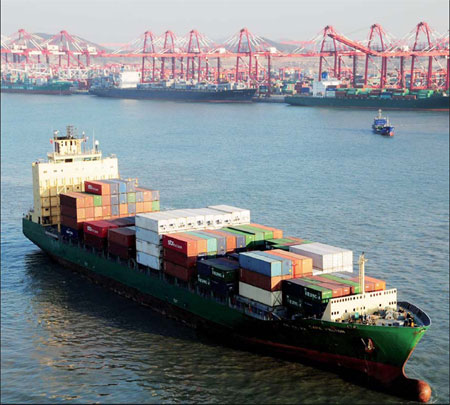

Shipping port under construction near London could be gateway for Chinese imports
To satisfy Britain's appetite for imports from China, one shipping port is advertising its cost-effective infrastructure as a way to gain new business.
Currently under construction some 40 km east of London is the United Kingdom's newest deep-sea container port combined with one of Europe's largest logistics parks. With an estimated job creation of 36,000, the 1.5 billion pound ($2.3 billion, 1.8 billion euros) project, called London Gateway, is Britain's latest initiative to facilitate growing Sino-British trade. The first three of six berths will open in late 2013.
 |
|
The large number of containers from China is seen as a business opportunity for London Gateway port. Provided to China Daily |
Simon Moore, chief executive of London Gateway, expects at least 70 percent of containers arriving from China. To win deals from Chinese cargo owners, he is leading a delegation to the top supply chain trade event in Hong Kong, TOC Container Supply Chain: Asia, in March. Immediately after the gathering, the group will meet businessmen from several manufacturing hubs on the Chinese mainland.
Shipping containers, which are typically 20 feet long and 8 feet wide, are measured in 20-foot equivalent units (TEU).
With a capacity of 3.5 million TEU a year, London Gateway will be almost as large as Felixstowe, currently Britain's biggest port with capacity in excess of 4 million TEU, and about twice the size of Southampton, Britain's next largest port. The developer of the newest port is Dubai-based DP World, the third-biggest ports company in the world.
The company says proximity to the British capital will give its customers a cost-saving advantage of 70 pounds per TEU on average compared to Felixstowe. Moffatt and Nichol, a California-based engineering consulting firm, has verified the statistics.
Moffatt and Nichol also estimates that 46.5 percent of total 2010 UK imports in cargo terms are from China. This implies Chinese cargo owners can potentially save more than 500 million pounds between 2012-23 by choosing London Gateway over other British ports.
Today, most imported consumer goods from East Asia enter Britain through Felixstowe or Southampton and travel on an 18-wheeler to a cluster of warehouses around Leicester, in the English Midlands. At the new port, containers can be transferred straight to warehouses on site, with the cargo leaving in smaller loads going directly to the shops in the southeast. Officials at London Gateway say this will save millions of miles and is equivalent to taking 2,000 vehicles a day off Britain's roads.
But Paul Davey, a spokesman for Hutchison Ports, which owns Felixstowe, says that Felixstowe's proximity to major shipping lines will minimize ships' deviation when they transport cargo to several European countries at once. Additionally, it can transport imports to North England without experiencing traffic delays in London, a potential problem for London Gateway.
According to Clemence Cheng, managing director of Hutchison Port's central Europe division, Felixstowe is the largest port for container trade with China. Currently, cargo from China accounts for about 40 percent of Felixstowe's capacity.
Even though it just opened two new berths in November, Felixstowe plans to expand capacity to 6 million TEU by 2020, and 8 million TEU by 2030.
London Gateway is currently in negotiations with major shipping lines, the details of which have not been disclosed. But its CEO, Moore, says he "would not be surprised to see major Asian shipping lines at London Gateway".
Major Danish shipping company AP Moller-Maersk, which owns the world's biggest container line, says that it is watching London Gateway's development closely, but ships are committed to Felixstowe for a few years.
Meanwhile, rival facilities are springing up all over northern Europe and Rotterdam, Antwerp and others building extra cargo-handling capacity. But Vince Cable, Britain's business secretary, says the new port will "crucially strengthen our links with Asia and beyond", according to a statement issued by London Gateway.
Behind the scenes, big container ship operators expected to use the added capacity are, however, squealing with financial pain and cutting back services.
AP Moller-Maersk announced a 78 percent year-on-year drop in third-quarter profits last year because of declining freight rates. The current level of liner rates is "totally unsustainable", CEO Nils Andersen was quoted as saying in The (London) Guardian.
Chinese shipping companies are also being squeezed by the downturn in world trade and soaring fuel costs.
Cash flow problems faced by Grand China Logistics, the shipping unit of Hainan-based HNA Group, are likely to worsen this month after it handed back at least two chartered vessels to their owners. They face a possible ship seizure over late fuel payments, according to the Financial Times.
China Ocean Shipping Co, operator of the world's largest dry bulk shipping fleet, halted payments on some long-term charters in mid-2011 to force owners to cut the rates they were charging. COSCO eventually backed down after owners threatened large-scale seizures of the company's ships, the Financial Times reported.
Chinese exports to Europe dropped 9 percent in October compared with the same period in 2010. Wang Shouwen, foreign trade director of China's Ministry of Commerce, told the BBC last year that the "foreign trade situation will be severe" in 2012.
But Moore remains optimistic. He argues that increasing efficiency is driving down the cost of production over time, so decreasing trade in dollar value doesn't necessarily mean a reduction in the amount of cargo being transported.
Trade between China and the UK nearly reached $60 billion (47 billion euros) last year, Chinese Ambassador Liu Xiaoming said in London in early January. The two countries want to increase the value of bilateral trade to $100 billion per year by 2015.
But Neil Davidson, a senior adviser at the shipping consultant firm Drewry, says that the utilization level of London Gateway's capacity is questionable in the short term.
"The shipping market is one with a small number of big customers, so adding a big lump of new capacity may create risk for all ports. In the short term, London Gateway may be taking customers away from competitors. Although in the longer term, it may help to accommodate increasing imports into the UK," Davidson says.
"Trade will be mainly determined by bilateral political and economic relations, which cost savings delivered by individual ports can scarcely influence," he adds.
Notable ports in Britain
About 90 percent of the United Kingdom's imported goods arrive by sea lanes. The country now has more than 950 ports, harbors, jetties and piers around the coastline, according to the ports.org.uk website.
The Port of Felixstowe, on the east coast of England, is the country's biggest container port, dealing with roughly 40 percent of the UK's container cargo. Operating two modern container terminals, it handles more than 4 million 20-foot equivalent units (TEU) a year.
It is the fifth-largest port in all of Europe and is the main destination for cargo from China.
Apart from Felixstowe, the Port of Southampton, on the south coast, is another major destination for cargo from China and East Asia, and the UK's second-largest port.
As is the London Gateway, Dubai-based DP World also operates the Southampton port. The current container terminal has an estimated annual capacity of 2 million TEU.
It is expected to add up to 750,000 TEU of handling capacity by 2013, according to a February 2011 report.
It is lauded as "one of the country's busiest and most successful deep-water ports" by ports.org.uk.
The Southampton port has the facilities to handle virtually any type of cargo. Its natural deep-water harbor and unique double tide allow unrestricted access for the world's largest vessels.
Seacliff on the coast of east Scotland is, indisputably, the UK's smallest harbor.
Measuring no more than 12 meters along its longest side, and an entrance barely 2 meters across, this is the original one-man, one-boat harbor. It is blasted out of the Gegan Rock, the promontory overlooked by the imposing ruins of the Tantillan Castle.
Land access to the harbor is only possible by tramping across a sandy beach, then jumping over rock pools.
China Daily







